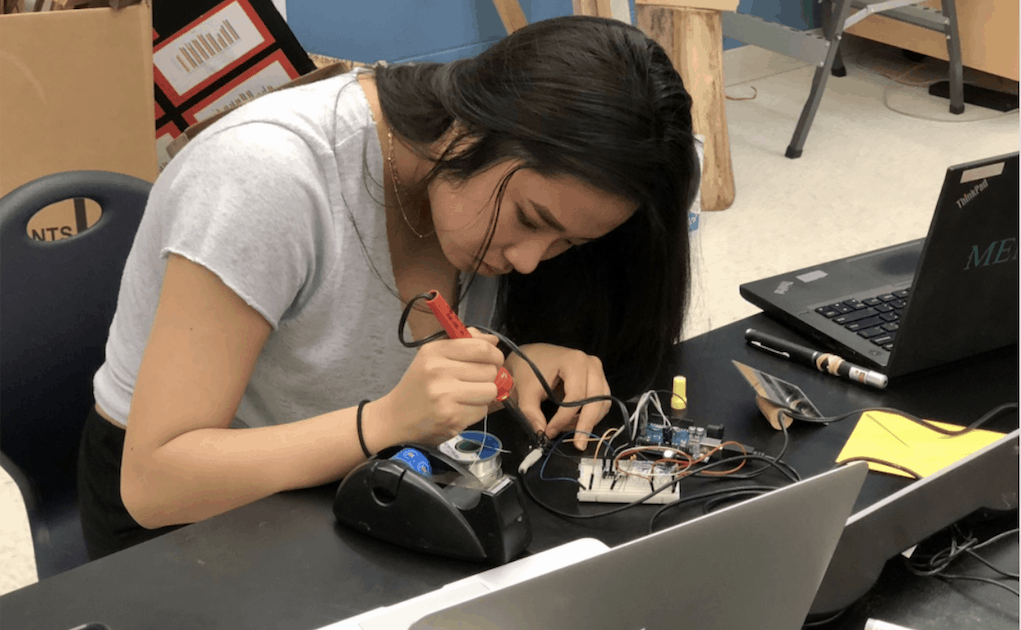Why High School Students Deserve Extended Challenges

Most schools value compliance and routines–worksheet assignments, small blocks of content, and a predictable daily schedule.
Most young people are going to lead lives full of uncertainty and complexity in a freelance economy buffeted by exponential technology and colliding systems.
To contribute now and in the future, young people deserve extended challenges–long projects that take on tough problems. To build agency and collaboration, students and teachers can co-construct projects that cross disciplines and result in public products that make real contributions.
There are seven key design variables for projects. They range from short teacher-designed and managed activities to long-term student defined projects:
- Outcomes: Clearly defined up front, guided discovery, or open-ended
- Direction: Teacher designed, product options, topic options, or student designed
- Scope: Focused (modern poetry), integrated (bioinformatics) or multidisciplinary (STEAM)
- Steps: Short problems, multi-step project, or extended multi-step challenge
- Approach: Individual or team
- Manager: Teacher managed, heavy scaffolding, teacher coaching, or student managed
- Combinations: Project-based learning, projects and personalized learning, or multiple learning strategies
Short teacher directed projects can be useful at achieving specific outcomes, but big integrated challenges boost students agency, communications, and pathfinding to encounter new situations. Projects with no right answer develop design skills, they require research, empathy, and prototyped solutions. Extended projects also teach collaboration and project management.
Extended challenges allow students to take on local versions of some of the most important issues in the world such as poverty, clean water, sustainable agriculture, and the safe use of artificial intelligence. Students at schools where extended challenges are core to their learning progressions often start with a topic of high-interest and high-need that is right in their backyard and then seek ways to apply that knowledge or understanding on a global scale.
Picture of Good
Many schools are still focused on passing tests. Following rules and routines guarantees a good grade. The move to mastery requires a picture of what good looks like. We shouldn’t assume that young people know what a good publication, research report, or campaign looks like.
Ron Berger developed Models of Excellence, a curated, open-source collection of exemplary high-quality K-12 student work. The purpose of the site is “to catalyze the use of models to help build student skills and dispositions for success in college, careers and life.”
Where we’ve seen teenagers do world class work it’s not just a product of individual teacher practice, but part of a school model, culture and community. Three practices appear to be critical to spinning the flywheel of high expectations:
- Outside in. A school culture that brings the outside in and where open feedback is valued.
- Real work for real clients. Authentic challenging work combined with expectations of value creation are an invaluable learning experience.
- Public work. Requiring regular public presentations of work creates a global audience, and can lay the groundwork for a legacy of quality.
With the help of over 90 partners and 3,600 schools, we developed and launched a framework for high quality project based learning that stresses authentic intellectual challenges, that require collaboration and reflection, and result in a public product.
The highest quality student experiences are those that extend over longer periods of time and require students to grapple with really intellectually challenging and complex problems. Throughout the duration of the project students weave in and out of individual, partnered and team challenges, all adding to the final product they are working to create–a production, publication, or presentation they’ll remember in 20 years.
Schools in the New Tech Network embrace team-taught integrated projects. Most existing schools don’t have the schedules, double classrooms, or tools to support extended challenges. They will need to work from the edges integrating where possible; an occasional integrated block where teachers collaborate or an intersession period or an after school robotics club.
As Seth Godin suggested, we need young people that, like firefighters running into a burning building, attack complexity and uncertainty with purpose, skill, confidence, and teamwork. That requires extended challenges.
For more see:
- High quality project based learning (HQPBL)
- Better Together: How to Leverage School Networks for Smarter Personalized and Project Based Learning
- What’s Up With All the Design-Focused Schools?
- New from Buck Institute: 6 Videos of PBL Units in Action
This post was originally published on Forbes.
Stay in-the-know with all things edtech and innovations in learning by signing up to receive the weekly Smart Update.





0 Comments
Leave a Comment
Your email address will not be published. All fields are required.